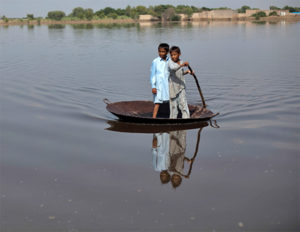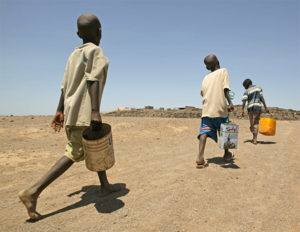Engineering our children’s climate?

Climate change affects every aspect of our children’s lives—from the quality of the air they breathe, to whether their home or school is protected from rising seas and more extreme weather. Reducing the risks from climate change will enable the young to not only survive, but thrive.
More than half the world’s population is now under the age of 25, as UN Secretary General António Guterres pointed out during this year’s General Assembly. Today’s youth—and all future generations—will live with the consequences of how we respond to climate change.

Over half a billion children live in extremely high flood occurrence zones. / UNICEF photo from “Unless We Act Now”
UNICEF’s 2015 publication “Unless We Act Now” warned that hundreds of millions of today’s children live in areas that are most exposed to climate change, meaning they face more droughts, floods, heatwaves and other severe weather conditions.
“This will contribute to the increased spread of major killers of children, such as malnutrition, malaria and diarrhea,” the report said. “These are particularly dangerous for very young children as they can impede their early development, with lifelong, irreversible impacts.”
It added: “climate change can also create a vicious circle: a child deprived of adequate water and sanitation before a crisis will be more affected by a flood, drought, or severe storm, less likely to recover quickly, and at even greater risk when faced with a subsequent crisis.”
That is why we must put the well-being of children and future generations front and center in our thinking when considering how to meet the safe temperature thresholds set out in the Paris Agreement.
An increasing number of scientists are casting doubt on our ability to stay below 1.5–2C temperature rise through incremental mitigation efforts. Nothing less than a massive, immediate decarbonization of the global economy is needed. We need to make radical mitigation job number one to create a safer future for our children and grandchildren.
There is a serious risk, however, that we may not do so at the speed or scale needed to stay below the 1.5–2C threshold. That is why there is now increased attention on other approaches, including carbon removal technologies or “negative emissions” as well as more extreme measures such as solar geoengineering, which is still in the development phase but could move to outdoor experiments as soon as next year.

Extreme heat will become a growing and regular problem in many parts of the world. / UNICEF photo from “Unless We Act Now”
Taking the right decisions means weighing the many risks—both known and unknown—of using these technologies against the risks of letting temperatures rise beyond 2C and approaching 3C or higher within the lifetime of a child before today.
If and when geoengineering is ever used, it could have profound impacts effects on children’s health, development, human rights and safety, including from political instability that might be triggered by use of these technologies.
At the same time, we already know our current emissions pathway is filled with grave risks to children’s well-being, and that climate impacts resulting from our current fossil-fuel based economy “will extend longer than the entire history of human civilization thus far.”
So which path is best?
This is not an academic question. The well-being of hundreds of millions of children depend on our having an open, honest, society-wide discussion on how the world should govern technologies that have planetary-wide impacts for generations to come.
Currently there is no comprehensive rules of the road or intergovernmental agreements to try to answer these questions.
To date, UN entities have largely not addressed the issue, with important but limited exceptions. The IFRC is thus far unique among humanitarian groups in already engaging deeply in these debates.
These discussions are too important to leave to scientists alone. All of society—including young people—should have an opportunity to dig into these issues and express their views to their leaders on how geoengineering should be governed.
That is why we at the Carnegie Climate Geoengineering Governance Initiative are helping to shift this conversation from the scientific world to the policy world and civil society.
We believe is more dangerous to ignore or deny the hard choices we as a society will face in the coming decades, than it is to have a frank, open discussion today on how to govern geoengineering technologies, if and when they are used.
After all, this about the world we are bequeathing to our children. And it is our children—and theirs after them—who have the most to gain, or lose, from our decisions.